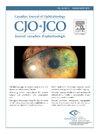免疫检查点抑制剂联合或不联合化疗治疗眼眶、结膜和眼附件鳞状细胞癌。
IF 3.3
4区 医学
Q1 OPHTHALMOLOGY
Canadian journal of ophthalmology. Journal canadien d'ophtalmologie
Pub Date : 2025-02-01
DOI:10.1016/j.jcjo.2024.05.018
引用次数: 0
摘要
目的:眼周鳞状细胞癌(SCC)相对罕见,由于靠近眼部以及高剂量放疗或根治性手术对眼部结构造成的风险,它提出了独特的解剖学考虑。为了降低手术发病率或避免大剂量放疗,我们对接受免疫检查点抑制剂(ICI)治疗的眼周SCC患者进行了观察:回顾性研究眼眶、结膜或眼周SCC患者,这些患者在手术前的新辅助治疗中或为治疗眼眶/颅底的神经周围扩散而接受了ICI治疗:12名男性和5名女性眼眶(6例)、结膜(5例)或泪囊/导管(2例)SCC患者,或有神经周围扩散(4例)的SCC患者接受了ICI(cemiplimab或pembolizumab)单药治疗(9例)或联合化疗(8例)。根据 RECIST 标准,5 名患者获得完全应答,8 名患者获得部分应答,4 名患者病情稳定。客观反应率为 76.5%。12例患者在手术前的新辅助治疗中使用了ICI。4名患者的病灶有神经周围扩散且无法切除,使用ICI是为了避免大剂量放疗。还有一名结膜 SCC 结节转移患者在接受 ICI 单药治疗后,获得了显著的完全反应,并成功避免了手术:结论:ICI 无论是作为单一药物还是与化疗联合使用,在眼周 SCC 患者中都有很高的反应率。未来的前瞻性试验应着眼于将分子数据与反应相关联。本文章由计算机程序翻译,如有差异,请以英文原文为准。
Immune checkpoint inhibitors with or without chemotherapy for orbital, conjunctival, and ocular adnexal squamous cell carcinoma
Objective
Periocular squamous cell carcinoma (SCC) is relatively rare and presents unique anatomic considerations due to proximity to the eye and risk to ocular structures associated with high-dose radiation therapy or radical surgery. We present our observations in patients with periocular SCC treated with immune checkpoint inhibitor (ICI) therapy in an effort to decrease surgical morbidity or avoid high-dose radiation therapy.
Methods
Retrospective review of patients with orbital, conjunctival, or periocular SCC who were treated with ICI either in the neoadjuvant setting prior to surgery or for treatment of perineural spread in the orbit/skull base.
Results
Twelve men and 5 women with orbital (n = 6), conjunctival (n = 5), or lacrimal sac/duct (n = 2) SCC, or SCC with perineural spread (n = 4) were treated with ICI (cemiplimab or pembolizumab) either as single drug (n = 9) or combined with chemotherapy (n = 8). Overall, 5 patients achieved complete response, 8 patients achieved partial response, and 4 patients achieved stable disease, using the response evaluation criteria in solid tumors (RECIST) criteria. The objective response rate was 76.5%. In 12 patients ICI was used in the neoadjuvant setting prior to surgery. In 4 patients with perineural spread and unresectable disease, ICI was used to avoid high-dose radiation therapy. One additional patient with conjunctival SCC with nodal metastasis was treated with ICI alone and achieved a dramatic complete response and has thus far managed to avoid surgery altogether.
Conclusions
ICI either as single drug or in combination with chemotherapy has a high response rate in patients with periocular SCC. Future prospective trials should aim to correlate molecular data with response.
Objectif
Le carcinome épidermoïde périoculaire, cancer relativement rare, est assujetti à des considérations anatomiques uniques en raison de la proximité de l’œil et du risque que posent la radiothérapie fortement dosée ou la chirurgie radicale pour les structures oculaires. La présente étude porte sur l'administration d'un traitement reposant sur un inhibiteur de points de contrôle immunitaire (ICI) dans le carcinome épidermoïde périoculaire afin de réduire la morbidité chirurgicale ou d’éviter la radiothérapie fortement dosée.
Méthodes
Il s'agit d'une revue de synthèse rétrospective de patients atteints d'un carcinome épidermoïde orbitaire, conjonctival ou périoculaire qui ont reçu un ICI à titre néoadjuvant avant la chirurgie ou à titre thérapeutique en raison d'une extension périneurale dans l'orbite ou à la base du crâne.
Résultats
Ainsi, 12 hommes et 5 femmes qui présentaient un carcinome épidermoïde orbitaire (n = 6), conjonctival (n = 5) ou du sac/canal lacrymal (n = 2) ou encore un carcinome épidermoïde s'accompagnant d'une extension périneurale (n = 4) ont reçu un ICI (cémiplimab ou pembrolizumab), soit en monothérapie (n = 9), soit en association à une chimiothérapie (n = 8). Dans l'ensemble, 5 patients ont bénéficié d'une réponse complète, 8 patients, d'une réponse partielle et 4 patients, d'une stabilisation de la maladie, selon les critères RECIST (Response Evaluation Criteria in Solid Tumors). Le taux de réponse objective se chiffrait à 76,5 %. L'ICI a été administré à titre néoadjuvant avant la chirurgie chez 12 patients. L'ICI a été administré pour éviter une radiothérapie fortement dosée chez 4 patients qui présentaient une extension périneurale et un cancer non résécable. Un dernier patient atteint d'un carcinome épidermoïde conjonctival s'accompagnant de métastases ganglionnaires a reçu l'ICI en monothérapie et a bénéficié d'une réponse complète spectaculaire et a pu éviter complètement la chirurgie jusqu’à maintenant.
Conclusions
Les ICI, administrés en monothérapie ou en association à la chimiothérapie, procurent un taux de réponse élevé chez les patients atteints d'un carcinome épidermoïde périoculaire. De futures études prospectives devront examiner le lien entre les données moléculaires et la réponse au traitement.
求助全文
通过发布文献求助,成功后即可免费获取论文全文。
去求助
来源期刊
CiteScore
3.20
自引率
4.80%
发文量
223
审稿时长
38 days
期刊介绍:
Official journal of the Canadian Ophthalmological Society.
The Canadian Journal of Ophthalmology (CJO) is the official journal of the Canadian Ophthalmological Society and is committed to timely publication of original, peer-reviewed ophthalmology and vision science articles.

 求助内容:
求助内容: 应助结果提醒方式:
应助结果提醒方式:


